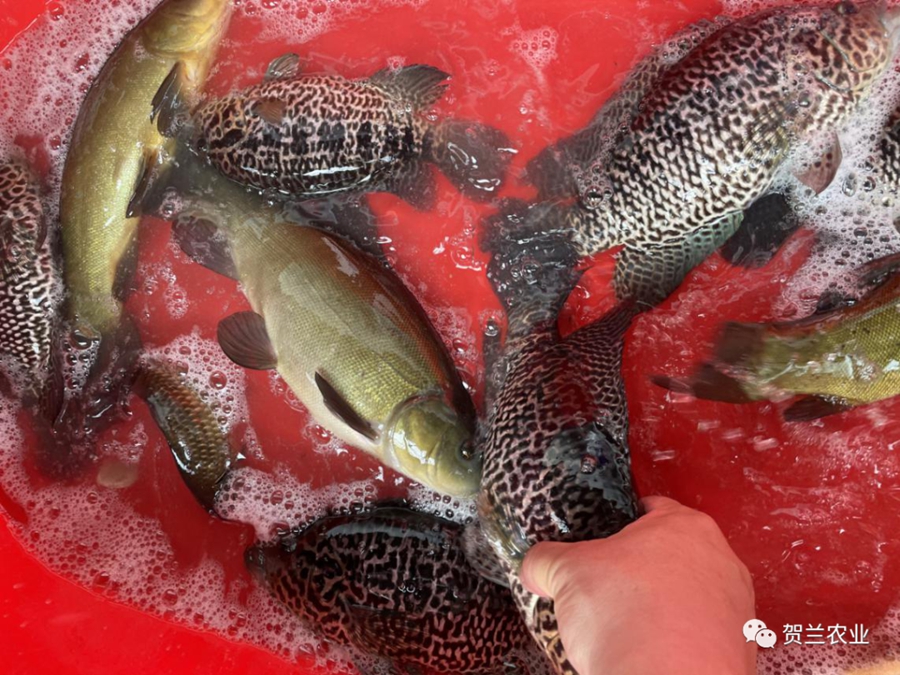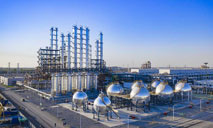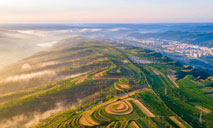Technological innovation enables fish farmers in NW China to increase income while treating wastewater (4)
 |
| Photo shows bass and groupers raised by farmers in Helan county, northwest China’s Ningxia Hui autonomous region. (Photo/WeChat account of Helan agriculture and rural affairs bureau) |
Because of technological innovation, Helan county, Yinchuan city, northwest China’s Ningxia Hui autonomous region, which faced challenges in developing aquaculture as it is located in an inland region, has managed to increase fish farmers’ income while realizing effective control of wastewater.
Earlier in July, Helan’s first batch of 150,000 farmed bass hit the market, about one month earlier than the fish transported from southern areas of China to the county in the past. The high quality bass have been well received in the market, with the unit price of big bass being 40 yuan ($6.18) higher per kilogram than the rest.
There has been a time when Wang Xujun, a fish farmer in Helan whose family has been in aquaculture for over 40 years, had been distressed by the fact that fish farming appeared less profitable in recent years.
To increase fish production and make more profits, Wang tried feeding fish plenty of food, which failed to stimulate the production and only made the water thicker.
“I spent a lot of money on the feed. However, less than 30 percent of it was absorbed by fish, and all the rest turned into sewage,” Wang said.
While hating to see the money on feed flow away with the tailwater, he was also worried as fish farmers were required to either treat sewage or shut down farms under tougher measures for environmental protection.
Jin Haoxuan, a teacher who specializes in water environment management in Tsinghua University, brought technologies for dealing with tailwater to Wang‘s fish farm. Since fish farmers couldn’t make much money, not to mention they now need to bear the cost of sewage treatment, fish farmers’ economic conditions must be taken into consideration in sewage treatment, according to Jin.
Considering that avoiding pollution at the source is more important than disposing of the polluted tailwater, Jin and his team members stayed in Ningxia for four years and researched into technologies related to fish farming.
Jin’s team focused their attention on helping farmers make good use of water and cultivate high-quality fish, in a bid to increase their income and make them more motivated to protect the environment.
Fish farmers in Ningxia used to raise only grass carp and several other species that are easy to raise but priced low in the market. Due to unfavorable temperature and climate, farmers in Ningxia couldn’t cultivate fish native to south China including bass, which have tenderer meat and higher prices.
The previous model of drawing water and discharging wastewater recklessly and trying to drive production through enhancing the input of feed didn’t work, Jin told farmers. Noting that local farmers have the benefit of using high-quality water from the Yellow River, Jin suggested that farmers raise fish species that are hugely popular in the market.
“Bass is charged over four times the price of grass carp. We will listen to your advice if you can prove that bass can be raised here,” fish farmers said to Jin.
Jin’s team then started to study the cultivation of bass based on the habits of the fish species and local conditions. Bass likes clean water and usually stops feeding when the water gets dirty. The water temperature in Ningxia is low, and every time fish farmers change water, they will cause a drop in temperature at the fish ponds. As the sunlight is strong in Ningxia, algas grow wildly due to eutrophication of water and cause oxygen deficiency for fish. Besides, with long cold days, it is very likely that when fish from the southern areas are ready for the market, local fish haven’t grown up yet.
To address these problems, Jin’s team figured out a model which features small pond and fine management to allow fish farmers to maintain and control the temperature and other conditions of fish ponds.
After many trials, the team finally proved a method of raising fish at greenhouses and small ponds while purifying the water successful.
They have changed harmful ammonia nitrogen and nitrite into harmless substances with microorganisms, and residual fish feed and feces into fertilizers with water circulation equipment. A fish pond only produces a few glasses of such substances and fertilizers. Except for evaporation, there is almost no water loss.
The transformed fish farms need less water and have witnessed rising production and benefits. They can produce 2,000 kilograms of bass a year with 200 cubic meters of water. Besides, raising bass is now even cheaper than raising carp in the past. Ningxia used to introduce fish from south China, which led to many losses during transportation. Nowadays, the local high-quality fish hit the market earlier than those from south China, and are highly competitive in the market even with their high prices.
The fish farming model of Jin’s team allows farmers like Wang to increase their income while controlling the pollution at a low cost. It has been supported and promoted by the science and technology bureau and the agriculture and rural affairs bureau of Yinchuan.
Five major fish farming households have participated in trial breeding under the model, 27 leading companies have confirmed to join, and thousands of individual fish farmers will observe the cultivation and receive training in batches.
It is believed that more fresh fish from Ningxia will be served on the tables of residents in northwest China in the near future.
 |
Photos
Related Stories
Copyright © 2021 People's Daily Online. All Rights Reserved.










